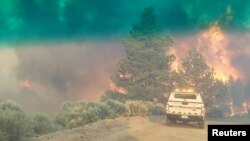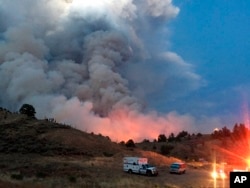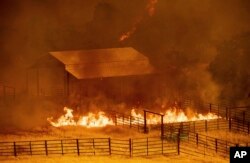More than 100 homes in the Colorado mountains were destroyed by a growing wildfire, while hundreds of others across the parched U.S. West remained under evacuations Tuesday and the closure of recreation areas derailed holiday plans.
Authorities announced late Monday that a fire near Fort Garland, about 205 miles (330 kilometers) southwest of Denver, had destroyed 104 homes in a mountain housing development started by multimillionaire publisher Malcolm Forbes in the 1970s. The damage toll could rise because the burn area is still being surveyed.
Ellen Booth and Larry Booth told KRDO-TV in Colorado Springs that they lost their vacation home where they planned to live in retirement and were not able to insure because of recent destructive fires in Colorado. Despite losing antiques and family paintings, they felt fortunate.
"All my neighbors, that's their primary home. This is just a second home to us," said Ellen Booth, who described the burned area as looking like it had been hit by a bomb.
The fire, labeled the Spring Fire, is one of six large wildfires burning in Colorado and the largest at 123 square miles (318 square kilometers), about five times the size of New York's Manhattan. While investigators believe it was started by a spark from a fire pit, other fires, like one that began burning in wilderness near Fairplay, were started by lightning.
Nearly 60 large, active blazes are burning across the West, including nine in New Mexico and six each in Utah and California, according to the National Interagency Fire Center.
Utah
In Utah, authorities have evacuated 200 to 300 homes because of a growing wildfire near a popular fishing reservoir southeast of Salt Lake City amid hot temperatures and high winds. Several structures have been lost since the fire started Sunday, but it's unclear how many, said Jason Curry of the Utah Division of Forest, Fire and State Lands.
Darren Lewis and his extended family had planned to spend the Fourth of July at a cabin built nearly 50 years ago by his father and uncle in a wilderness area that is nestled between canyons and sits near a mountain river.
Instead, Lewis and his family will spend the holiday nervously waiting to hear if a half century of family memories go up in smoke because of the fire, which has grown to 47 square miles (122 square kilometers).
"There's a lot of history and memories that go into this cabin," said Lewis, 44, of Magna, Utah. "The cabin we could rebuild, but the trees that we love would be gone. We're just hoping that the wind blows the other way."
Northern California
Meanwhile, a wind-fueled wildfire in Northern California that continues to send a thick layer of smoke and ash as far as south of San Francisco was threatening more than 900 buildings.
The massive blaze was choking skies with ash and smoke, prompting some officials to cancel Fourth of July fireworks shows and urge people to stay indoors to protect themselves from the unhealthy air.
At least 2,500 people have been told to evacuate as the sprawling blaze continues to spread, said Anthony Brown, a spokesman with the California Department of Forestry and Fire Protection.
Brown said the blaze that started Saturday and is surging through rugged terrain northwest of Sacramento has grown to 109 square miles (280 square kilometers) amid hot and dry weather expected throughout the day. It was 5 percent contained.
"The weather is better than what we had over the weekend. But it's still hampering our efforts and it's an area of concern," he said.
So far this year, wildfires have burned 2.7 million acres in the United States, according to the fire center. That's a bit below last year's acreage to date — which included the beginning of California's devastating fire season — but above the 10-year average of 2.3 million acres.
Because of the Independence Day holiday, authorities are also concerned about the possibility of campfires or fireworks starting new fires because of the dry, hot conditions. In Colorado, many communities have canceled firework displays, and a number of federal public lands and counties have some degree of fire restrictions in place, banning things like campfires or smoking outdoors.
In New Mexico, all or part of three popular national forests remain closed because of the threat of wildfire, putting a damper on holiday camping plans. The forests that are open have strict rules, especially when it comes to fireworks.
"We're just urging people to use extreme caution," said Wendy Mason, a spokeswoman for the New Mexico State Forestry Division. "We want people to have fun and enjoy themselves, but we prefer they leave the fireworks shows to the professionals."







